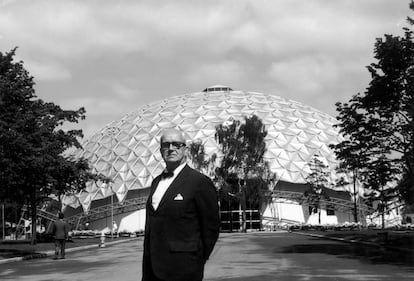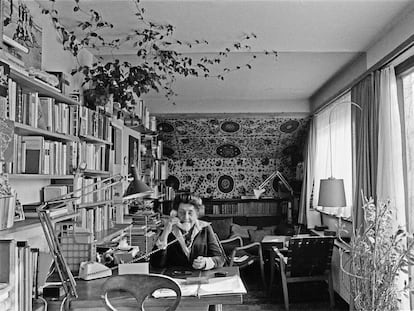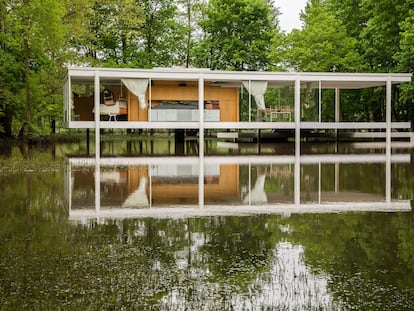Buckminster Fuller, the crazy genius that Steve Jobs turned into an icon
The American scientist, described as the first poet of technology, invented the geodesic dome in the post-war years and coined the concept of synergy. A new biography brings us closer to this optimistic visionary

Buckminster Fuller (1895-1983) has been described as the “Leonardo da Vinci of modernity” and the “first poet of technology.” His kind of vision is rare these days, because he genuinely believed in the future. He revolutionized the world of design by advocating resource efficiency, sustainability, universal housing and cost reduction. He published 30 books, holds 28 patents, was awarded 47 honorary doctorates, and coined popular terms like “synergetics.” For Fuller, society had the opportunity to establish a sustainable way of life by applying his principle of ephemeralization; to do more with less. He believed that technology could make the world work for everyone, lifting entire nations out of poverty, writes Alec Nevala-Lee, author of a new biography of his life, Inventor of the Future ( HarperCollins). But as Fuller put it, humanity has turned against itself by thinking that it is against technology.
Buckminster Fuller was born in the late 19th century, nearly blind, into a wealthy New England family. Until he was four years old, he was not given glasses, which made him trust his other senses more keenly. Concerned about his development, his parents enrolled him in a kindergarten that followed Friedrich Froebel’s methodology, in which kids played with spheres, cylinders and cubes and built small objects, activities that marked him deeply. His life was a continuous challenge. He faced his worst tragedy in 1922, when his four-year-old daughter died of pneumonia. The episode plunged him into a deep depression; he fell into alcoholism, abandoned his wife, to whom he was very close, for long periods (they would die just 36 hours apart) and took refuge in prostitutes and lovers. After five tumultuous years, he had a moment of revelation and regained the motivation to live, devoting all his energy to building a better world.
Instead of committing suicide, he committed egocide and decided to live for the benefit of humanity, Nevala-Lee explains in the book. That set him apart from other privileged minds: his main drive was to find solutions to pressing social problems. His direction was clear: Nature is a totally efficient and self-regenerating system, he saw. If humans could discover the laws that govern it and live synergistically within them, there would be sustainability and humanity could be successful.
Although he was eventually able to demonstrate the efficiency of his proposals, for most of his life he was considered a mere charlatan, as Time magazine highlighted in 1964, in an issue that also featured him on the cover. His main prowess lay in his persistence. Since 1927 he had worked on the Dymaxion, a concept that combines the words dynamic, maximum, and tension. He invested 20 years in unsuccessfully developing the project, which made him go through numerous economic ordeals.
The Dymaxion house aspired to solve the post-war urban crisis and was the first example of sustainable housing. They were cheap prefabricated houses, made of aluminium and very resistant. But they did not come to market; society was not yet ready for the purchase of mass-built houses. A similar fate befell the Dymaxion car, which Fuller designed together with the Japanese sculptor Noguchi in 1933. A three-wheeled car that only consumed 7.8 liters/100 km and could carry up to 11 passengers, it was an example of how its creator aspired to revolutionize the industry with vehicles that consumed less and could transport a greater number of people. A spectacular accident made investors rule out the possibility of commercializing it. Even so, Fuller was convinced that the implementation of his theories was a matter of time. “I invent and wait for man to come to need what I have invented,” he wrote.
Utopia and reality
Fuller was 45 years old when he managed to build his first geodesic dome, with which he achieved worldwide fame. He registered the patent in 1954, becoming the official inventor of this hemispheric structure that produces great energy savings by taking advantage of sunlight, as well as requiring minimal use of construction materials, which reduces time and costs. More than half a century later, in a society that is more aware of the consequences of climate change than ever, geodesic domes are once again taking center stage. There are around 300,000 around the world, the most emblematic of them being the Montreal Biosphere, which Fuller created for the 1967 Expo. Now home to the only environmental museum in North America, it remains an icon of modernism. In 2021 The New York Times included it in its list of the 25 most significant architectural works of the postwar period.
“The greatest test of Fuller’s philosophy has been the coronavirus pandemic,” highlights Nevala-Lee, who has written the most comprehensive biography of Fuller’s personal life, career and legend, with 128 footnotes. Nevala-Lee recalls that Fuller attributed the death of his daughter to the consequences of the 1918 flu pandemic, and although he died in the 1980s, he was already advocating for measures to avoid future pandemics. His vision of decentralization, streamlined manufacturing, online education and remote work are more relevant now than ever, notes his biographer. Because of this visionary nature, Steve Jobs made him an icon for Apple’s Think Different campaign in 1997, which alluded to those geniuses described as crazy who, however, are the ones who can change the status quo and, consequently, the world.
“There is no other thinker whose reimagining of the world through his constructions combines connectivities of scale, power, environment, climate, culture, and society,” says Sean S. Anderson, who directs the Bachelor of Architecture program at Cornell University, home to one of the world’s most prestigious schools of architecture. “He is a fascinating exponent of a hybrid character so necessary in our times: the architect/engineer; the technician/artist who is both in utopia and in reality”, adds Carlos Naya Villaverde, director of the Higher Technical School of Architecture of the University of Navarre in Spain. Naya notes that it continues to be a benchmark for Spanish students. “His work is applicable to the spirit of the New European Bauhaus. It is also in line with the industrialization of construction that we have been talking about so much in recent months.”
As Buckminster Fuller already said in the 1970s, “nature is trying hard to help us succeed, but nature is not dependent on us. We are not the only experiment.”
Sign up for our weekly newsletter to get more English-language news coverage from EL PAÍS USA Edition
Tu suscripción se está usando en otro dispositivo
¿Quieres añadir otro usuario a tu suscripción?
Si continúas leyendo en este dispositivo, no se podrá leer en el otro.
FlechaTu suscripción se está usando en otro dispositivo y solo puedes acceder a EL PAÍS desde un dispositivo a la vez.
Si quieres compartir tu cuenta, cambia tu suscripción a la modalidad Premium, así podrás añadir otro usuario. Cada uno accederá con su propia cuenta de email, lo que os permitirá personalizar vuestra experiencia en EL PAÍS.
¿Tienes una suscripción de empresa? Accede aquí para contratar más cuentas.
En el caso de no saber quién está usando tu cuenta, te recomendamos cambiar tu contraseña aquí.
Si decides continuar compartiendo tu cuenta, este mensaje se mostrará en tu dispositivo y en el de la otra persona que está usando tu cuenta de forma indefinida, afectando a tu experiencia de lectura. Puedes consultar aquí los términos y condiciones de la suscripción digital.
More information
Últimas noticias
Most viewed
- Reinhard Genzel, Nobel laureate in physics: ‘One-minute videos will never give you the truth’
- Oona Chaplin: ‘I told James Cameron that I was living in a treehouse and starting a permaculture project with a friend’
- Pablo Escobar’s hippos: A serious environmental problem, 40 years on
- Chevy Chase, the beloved comedian who was a monster off camera: ‘Not everyone hated him, just the people who’ve worked with him’
- Why we lost the habit of sleeping in two segments and how that changed our sense of time











































